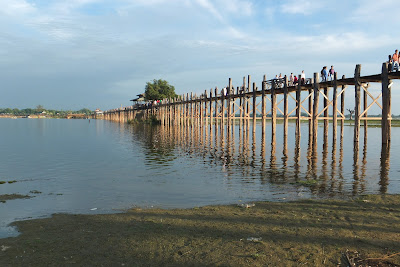Travel Date 17th November 2012.
Click on any picture to see a larger version.
I arranged a '3 cities tour' with the Sein Myanmar car service in the 7 Diamonds travel office. The car was air-conditioned and the driver understood English sufficiently to provide good information about the places visited.
I will let the pictures tell most of the story with a few words for explanation. These are just a selection of several hundred taken that day. The '3 cities' are Amarapura, Sagaing and ancient Ava. But first, while en-route to Amarapura we had to visit the obligatory gold leaf factory. These men are wielding very heavy sledge-hammers to pound the layers of gold flat between sheets of material. This is repeated for hours with successively thinner layers.
The leaf is then prepared for sale to the devout in ultra-thin postage stamp sizes. The buyers add it to a Buddha for good karma.
This gong and bells are in the grounds of the Mahamuni Temple; the gong looks like the one used for the opening of old J Arthur Rank films.
One of the larger populations of monks is in the Mahargandaryone Monastery in Amarapura. According to their web-site (yes, that surprised me too: Mahargandaryone Monastery; they appear to be developing their own travel agency. [Edit note in 2020, web-site has disappeared]) they have 657 monks, 717 novices and 57 acolytes in residence at this moment.
We arrived in late morning as the monks queued for their daily meal. I have very mixed feelings about the boys, some as young as five, who are chosen to become monks. Possibly they will have a better life than their civilian brothers, and possibly they get a chance to leave the monastery when they are older, but I still felt uncomfortable about the system. I try not to judge cultures as I wander other lands but there are times when that is more difficult than others.
The Kaungmudaw Pagoda is unusually dome-shaped and massive.
We crossed the bridge to Sagaing and drove to the pagoda complex atop the hill. The views were glorious in all directions.
From Sagaing we went to the river crossing to old Ava. The boatman waited until the craft had enough passengers to justify his effort. I became convinced that the Burmese have rubber knees, unlike the rest of humanity. They are able to comfortably squat like this or to sit cross-legged yoga-style as a preferred method of seating for hours. My knees creaked just watching them.
The boatman charged 1000 kyats; the horse-cart driver needed another 6000. For a couple of hours of fascinating, slow, clip-clopping around the island it was well worth the price.
Ava has declined since it was was the ruler of Upper Burma from the 14th to the 16th century. There are ruins of stupas, temples and fortifications dotted around the countryside; some are poorly renovated, others just slowly decaying. There appear to be no internal combustion vehicles on the island. The principal means of transport is the horse cart.
Ava has declined since it was was the ruler of Upper Burma from the 14th to the 16th century. There are ruins of stupas, temples and fortifications dotted around the countryside; some are poorly renovated, others just slowly decaying. There appear to be no internal combustion vehicles on the island. The principal means of transport is the horse cart.
This young boy seemed fascinated by the strange man with no hair.
I eventually spent quite a lot of time during my Myanmar visit on horse carts. I developed a new respect for my ancestors who lived prior to the motor car. This first one appeared to have springs when I checked after clambering down at the first stop, but my spine and my numb posterior disagreed with my eyes.
| Bagaya Kyaung monastery was built entirely of teak in the early 19th century. |
It is a working school. You can just see the knees of the monk on the right. He seemed very relaxed about the inattentiveness of several of his young students.
Normally the requirement to go barefoot in all Buddhist sacred areas is a minor inconvenience. However, in a very old wooden building it was wise to watch every step.
Traffic jam.
The Mahar Aung Mye Bon San Monastery was also built in the early 19th century but of sturdier material. However, it suffered more damage than the timber monastery when hit by earthquakes and needed extensive rebuilding in 1873.
These are pagodas beside the monastery.
It was a hot and dusty day. Myanmar beer is very acceptable.
When the wheel came off I gave a Swiss lady a lift back to the boat.
This was near the jetty. I saw several of these relics of the British era in Myanmar. The 12' full size billiard table was always in much better condition than the surrounding building.
Transport arriving for the journey back.
U Bein Bridge is the longest teak bridge in the world at 1.2 km or 3/4 mile. It is a little scary to walk across, because there are no hand-rails and the planks are irregular and rough. It was a long way above the river, but at peak flood time in the monsoon the river can reach the walkway. It was built when the capital moved from Ava (on Innwe Island) to Amarapura in the 19th century.
I stayed until sunset; a magical moment.
It was a long, dusty, hot, fascinating and very satisfying day.
Cheers, Alan































No comments:
Post a Comment